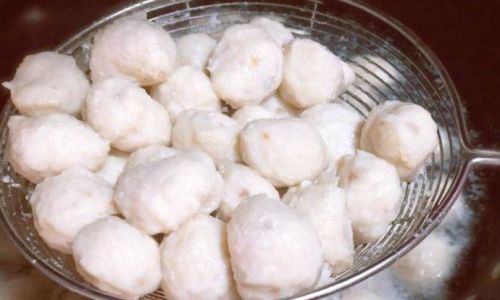Introduction
Hot pot, a beloved culinary tradition across Asia and increasingly popular worldwide, offers a delightful blend of flavors and textures. From tender slices of meat to crisp vegetables and an array of sauces, hot pot is a versatile dish that can cater to various tastes and dietary preferences. Among the myriad of ingredients that grace the boiling broth, hot pot meatballs hold a special place. These succulent morsels can be made from a variety of meats, seafood, or even vegetarian alternatives, each contributing its unique flavor and texture to the communal feast. However, ensuring that these meatballs are fully cooked is crucial for both safety and optimal eating experience. This article delves into the various methods and considerations for determining if hot pot meatballs are cooked to perfection.

Understanding the Importance of Cooking Meatballs Thoroughly
Before diving into the specifics of how to check for doneness, it’s essential to understand why cooking meatballs thoroughly is so important. Raw or partially cooked meatballs pose a significant risk of food poisoning, particularly from bacteria such as Salmonella, E. coli, and Campylobacter. These pathogens can cause severe illness, including vomiting, diarrhea, fever, and abdominal cramps. Therefore, ensuring that meatballs reach a safe internal temperature is paramount.
Moreover, fully cooked meatballs offer a more enjoyable eating experience. They are tender, juicy, and flavorful, with a pleasant texture that contrasts beautifully with the hot pot’s broth and other ingredients. Undercooked meatballs, on the other hand, can be tough, chewy, and lack the desired taste and mouthfeel.
Visual Indicators of Doneness
One of the simplest ways to assess if hot pot meatballs are cooked is by observing their appearance. Here are some visual cues to look for:
-
Color Change: Raw meatballs, especially those made from beef or pork, are typically a bright red or pink. As they cook, the proteins in the meat coagulate, causing the meatballs to turn a darker, more uniform brown or gray. While color alone is not a foolproof indicator of doneness (as some types of meat, like chicken, can remain pink even when fully cooked), it is a good starting point.
-
Shrinkage: As meatballs cook, they lose moisture and shrink slightly in size. This is a natural process that occurs as the proteins in the meat tighten and expel liquid. If your meatballs still look plump and juicy after a considerable amount of time in the hot pot, they may need more cooking.

-
Juices: When pierced with a fork or chopsticks, fully cooked meatballs should release clear or slightly opaque juices. If the juices are bloody or runny, the meatballs likely need more time to cook.
Temperature Check
The most reliable method for determining if hot pot meatballs are cooked is to use a food thermometer. Insert the thermometer into the thickest part of the meatball, ensuring that it does not touch any bone, fat, or gristle, which can give false readings. The internal temperature should reach:
- 145°F (63°C) for beef, pork, lamb, and veal meatballs.
- 165°F (74°C) for chicken and turkey meatballs.
- 145°F (63°C) or higher for fish and seafood meatballs, though they should be cooked until opaque and flaky.
It’s important to note that these temperatures are for whole pieces of meat. Since hot pot meatballs are smaller and often cooked in a liquid, they may reach safe temperatures sooner than larger cuts. However, using a thermometer provides an objective measure of doneness and eliminates guesswork.
Texture and Feel
In addition to visual cues and temperature checks, the texture and feel of the meatballs can also indicate their doneness. Here’s how to assess them:
-
Firmness: Fully cooked meatballs should feel firm to the touch. They should not be mushy or overly soft, which can indicate undercooking. At the same time, they should not be overly dense or dry, which can happen if they are overcooked.

-
Bounce: Gently press on a cooked meatball with your chopsticks or fork. A fully cooked meatball should have a slight bounce-back quality, indicating that the proteins have set and the meatballs are cooked through.
Cooking Techniques and Timing
The cooking time for hot pot meatballs can vary depending on their size, the type of meat used, and the intensity of the heat. Here are some general guidelines:
-
Small Meatballs: Generally, smaller meatballs (about 1-inch in diameter) will cook faster than larger ones. They may take anywhere from 3 to 5 minutes in a vigorously boiling broth.
-
Large Meatballs: Larger meatballs (2 inches or more in diameter) will take longer to cook, usually around 8 to 12 minutes.
-
Meat Type: Meatballs made from ground chicken or turkey may cook slightly faster than those made from beef or pork due to their lower fat content. Seafood meatballs, especially those made from fish, should be cooked gently to avoid overcooking and becoming mushy.
-
Broth Temperature: Maintaining a rolling boil will help cook the meatballs more evenly and quickly. However, be cautious of splashing and adjust the heat as necessary to maintain a steady simmer if the broth is too vigorous.

Final Thoughts
Determining if hot pot meatballs are fully cooked is a combination of art and science. By observing visual cues, using a food thermometer, and assessing texture and feel, you can ensure that your meatballs are safe to eat and delicious. Remember, the key to a successful hot pot experience is patience and attention to detail. Don’t rush the cooking process, and enjoy the communal joy of preparing and sharing this beloved dish with friends and family.
In addition to ensuring doneness, consider experimenting with different flavors, spices, and ingredients to elevate your hot pot meatballs. Whether you’re creating a traditional recipe or putting your own unique spin on the dish, the key is to have fun and enjoy the process. Happy cooking, and bon appétit!



0 comments